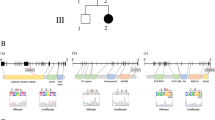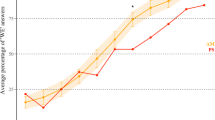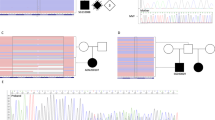Abstract
Prosopagnosia (PA) or face blindness is characterized by a deficiency in identifying familiar faces. Almost all reports are single cases or collections of unrelated patients who acquired prosopagnosia after brain injuries, strokes or atrophy of at least the right occipito-temporal cortex. Until 2001, the inborn form—in the absence of any brain lesions—was described in fewer than 20 probands exclusively of Caucasian origin. We recently found that in the German Caucasian population, congenital prosopagnosia has a very high prevalence of at least 2.5% and that it is genetically determined. It is best described by autosomal-dominant inheritance in the more than 50 families investigated. We therefore introduced the term non-syndromic hereditary PA for the congenital form of a monosymptomatic or isolated PA. This surprisingly high frequency in the Caucasian population prompted us to extend our search to other ethnic groups. We performed a questionnaire-based screening among 198 native Indian students at Banaras Hindu University in Varanasi. In a then selected subset, we found after further detailed diagnostic interviews one Bengali female student with visual agnosia for face recognition only. Several other members of her large family reported the same impairment of face recognition. The segregation pattern of PA in this family is also compatible with autosomal-dominant inheritance.
Similar content being viewed by others
Log in or create a free account to read this content
Gain free access to this article, as well as selected content from this journal and more on nature.com
or
References
Ariel R, Sadeh M (1996) Congenital visual agnosia and prosopagnosia in a child: a case report. Cortex 32:221–240
Bamshad MJ, Wooding S, Watkins WS, Ostler CT, Batzer MA, Jorde LB (2003) Human population genetic structure and interference of group membership. Am J Hum Genet 72:578–589
Basu A, Mukherjee N, Roy S, Sengupta S, Banerjee S, Chakraborty M, Dey B, Roy M, Roy B, Bhattacharyya NP, Roychoudhury S, Majumder PP (2003) Ethnic India: a genomic view, with special reference to peopling and structure. Genome Res 13:2277–2290
Behrmann M, Avidan G (2005) Congenital prosopagnosia: face-blind from birth. Trends Cogn Sci 9:180–187
Bentin S, Deouell LY, Soroker N (1999) Selective visual streaming in face recognition: evidence from developmental prosopagnosia. Neuroreport 10:823–827
Bodamer J (1947) Die prosop-agnosie. Arch Psychiatr Nervenkr 179:6–53
De Gelder B, Rouw R (2000) Configural face processes in acquired and developmental prosopagnosia: evidence for two separate face systems? Neuroreport 11:3145–3150
De Haan EH (1999) A familial factor in the development of face recognition deficits. J Clin Exp Neuropsychol 21:312–315
De Haan EH, Campbell R (1991) A 15 year follow-up of a case of developmental prosopagnosia. Cortex 27:489–509
Dobel Ch, Bölte J, Aicher M, Schweinberger SR (2007) Prosopagnosia without apparent cause: Overview and diagnosis of six cases. Cortex (in press)
Duchaine BC (2000) Developmental prosopagnosia with normal configural processing. Neuroreport 11:79–83
Duchaine BC, Parker H, Nakayama K (2003) Normal recognition of emotion in a prosopagnosic. Perception 32:827–838
Galaburda AM, Duchaine BC (2003) Developmental disorders of vision. Neurol Clin 21:687–707
Grueter M (2004) Genetik der kongenitalen Prosopagnosie (Genetics of congenital prosopagnosia). Thesis (MD). Muenster University
Grueter M, Grueter T, Bell V, Halligan PW, Horst J, Sperling K, Laskowski W, Ellis HD, Kennerknecht I (2007) Hereditary prosopagnosia: first case series. Cortex (in press)
Hasson U, Avidan G, Deouell LY, Bentin S, Malach R (2003) Face-selective activation in a congenital prosopagnosic subject. J Cogn Neurosci 15:419–431
Jones RD, Tranel D (2001) Severe developmental prosopagnosia in a child with superior intellect. J Clin Exp Neuropsychol 3:265–273
Kennerknecht I, Grueter T, Welling B, Wentzek S, Horst J, Edwards S, Grueter M (2006) First report on the prevalence of non-syndromic hereditary prosopagnosia (HPA). Am J Med Genet Part A 140A:1617–1622
Kivisild T, Rootsi S, Metspalu M, Mastana S, Kaldma K, Parik J, Metspalu E, Adojaan M, Tolk HV, Stepanov V, Gölge M, Usanga E, Papiha SS, Cinnioğlu C, King R, Cavalli-Sforza L, Underhill PA, Villems R (2003) The genetic heritage of the earliest settlers persists both in Indian tribal and caste populations. Am J Hum Genet 72:313–332
Kress T, Daum I (2003) Developmental prosopagnosia: a review. Behav Neurol 14:109–121
Kumar V, Reddy BM (2003) Status of Austro-Asiatic groups in the peopling of India: an exploratory study based on the available prehistoric, linguistic and biological evidences. J Biosci 4:507–522
McConachie HR (1976) Developmental prosopagnosia. A single case report. Cortex 12:76–82
Nunn JA, Postma P, Pearson R (2001) Developmental prosopagnosia: should it be taken at face value? Neurocase 7:15–27
Qintana-Murci L, Krausz C, Zerjal T, Sayar H, Hammer MF, Mehdi SQ, Ayub Q, Qamar R, Mohyuddin A, Radhakrishna U, Jobling MA, Tyler-Smith C, McElreavey K (2001) Y-chromosome lineages trace diffusion of people and languages in southwestern Asia. Am J Hum Genet 68:537–542
Saha A, Sharma S, Bhat A, Pandit A, Bamezai R (2005) Genetic affinity among five different population groups in India reflecting a Y-chromosome gene flow. Am J Hum Genet 50:49–51
Schwarzer G, Huber S, Grueter M, Grueter T, Groß C, Hipfel M, Kennerknecht I (2006) Gaze behavior in hereditary prosopagnosia. Psychol Res. DOI 10.1007/s00426-006-0068-0
Temple CM (1992) Developmental memory impairment: faces and patterns. In: Campbell R (ed) Mental lives: case studies in cognition. Blackwell, Oxford, pp 199–215
Warrington EK (1984) Recognition memory test. NFER NELSON, Windsor
Young AW, Ellis HD (1989) Childhood prosopagnosia. Brain Cogn 9:16–47
Acknowledgments
We want to thank all the students for participating in the questionnaire-based screening and the interviews. The help of Dr. Martina Grueter and Dr. Thomas Grueter, Münster, in performing a first check of part of the four-page questionnaires is highly appreciated.
Author information
Authors and Affiliations
Corresponding author
Rights and permissions
About this article
Cite this article
Kennerknecht, I., Plümpe, N., Edwards, S. et al. Hereditary prosopagnosia (HPA): the first report outside the Caucasian population. J Hum Genet 52, 230–236 (2007). https://doi.org/10.1007/s10038-006-0101-6
Received:
Accepted:
Published:
Issue date:
DOI: https://doi.org/10.1007/s10038-006-0101-6
Keywords
This article is cited by
-
Congenital prosopagnosia: multistage anatomical and functional deficits in face processing circuitry
Journal of Neurology (2011)



